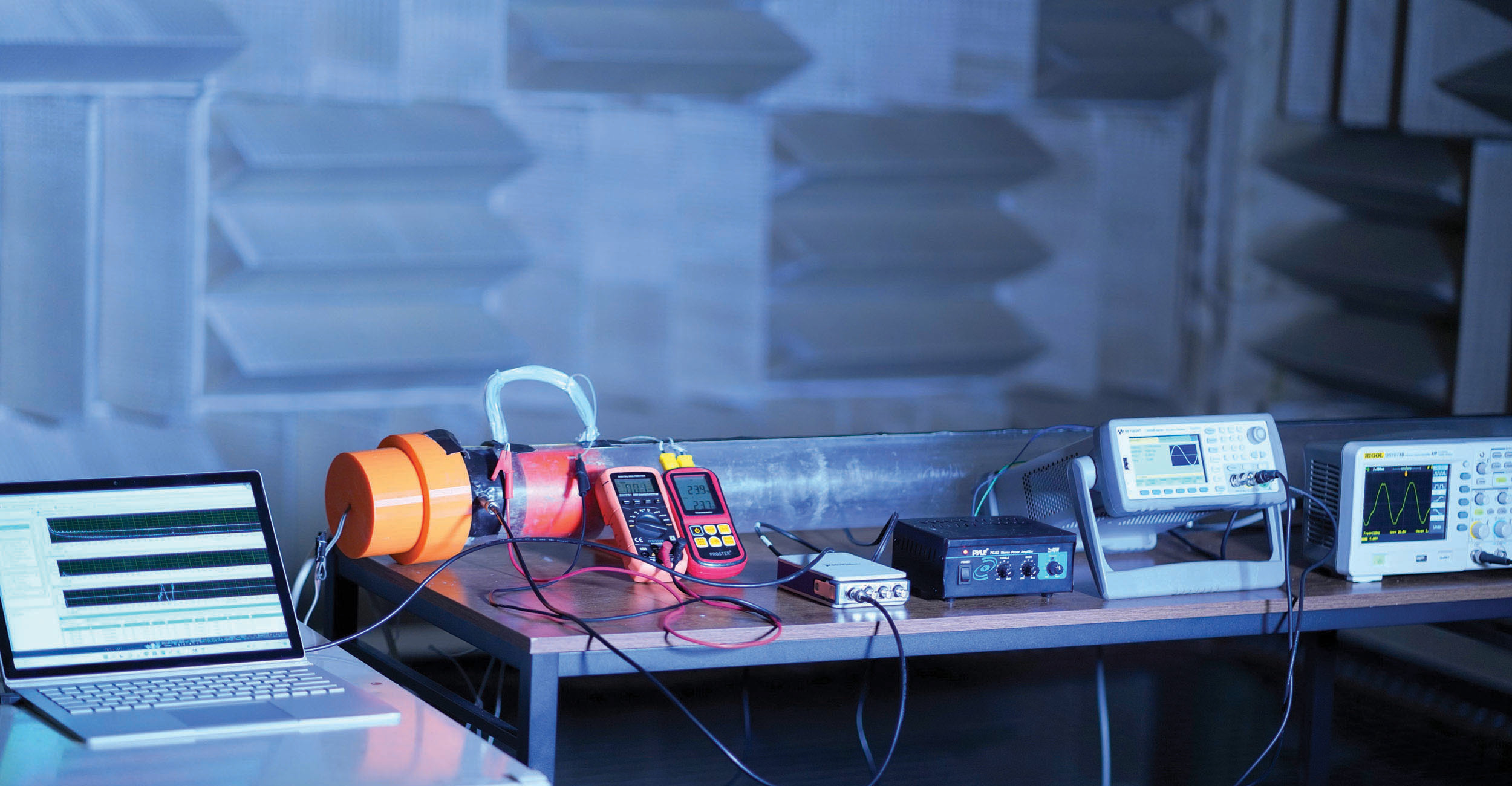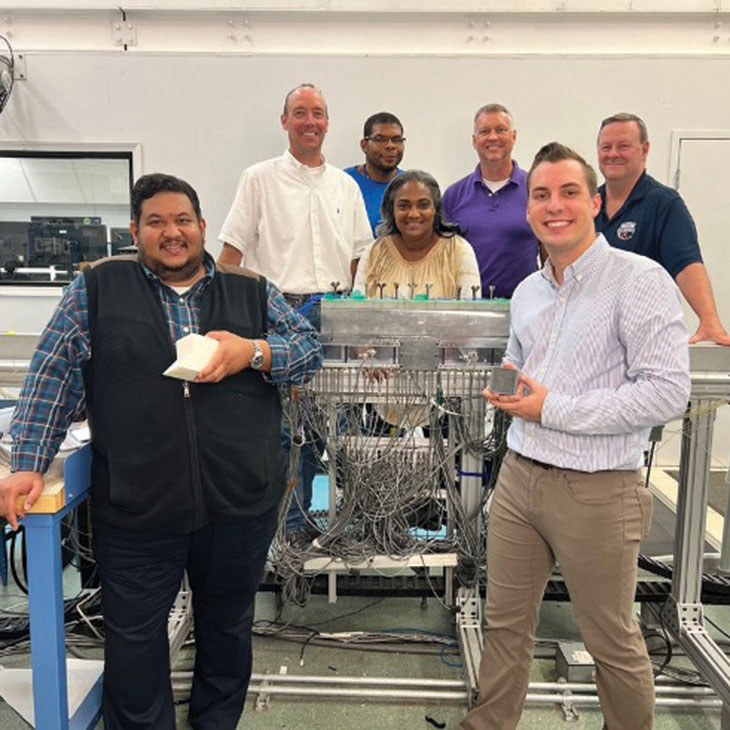
Researcher looks to solve problem of noisy cities
Friday, October 21, 2022
Media Contact: Harrison Hill | Senior Research Communications Specialist | 405-744-5827 | harrison.c.hill@okstate.edu
Oklahoma State University metamaterials researcher Dr. James Manimala is forging new
roads in acoustics.
His research has taken him all the way to NASA’s Langley Research Center, and has
implications for reducing noise and harvesting it as energy.
When Manimala was growing up in India, his family lived next to an airport. He and his friends would ride their bikes to the perimeter, take a seat on the surrounding wall and watch the airplanes come and go. It planted the seed for a love of airplanes that led to master’s and doctoral degrees in aeronautics and astronautics engineering. He’s currently an associate professor in the School of Mechanical and Aerospace Engineering and faculty director of the Solid and Structural Dynamics Lab at OSU.

Manimala is hoping that by combining materials, designs and processes, he can reduce noise problems plaguing aviation and aid society’s ability to harness acoustic energy.
“My thought is how can we create metamaterial designs in a way that the output is greater than the sum of the parts,” he said. “Two plus two can actually be five or six. You use the confluence of design innovations and materials in order to maximize multi-physical utility for structures.”
As jets have grown in size, the noise they produce has changed. The Boeing 777 engine is as round in diameter as the entire fuselage of its smaller cousin, the 737. The larger engines make a much lower frequency noise, which is more difficult to mitigate. At some of the busiest airports, like London’s Heathrow, they have stringent noise requirements and airlines pay a heavy fine for exceeding late-night decibel levels.
“Conventional approaches to reducing noise have been almost thoroughly exploited,” Manimala said. “They’ve been tried and tested and refined so most of the conventional technologies are operating at about the same level they would have operated, say, a decade ago.”
In the front lip of a jet aircraft engine is an acoustic liner made up of a honeycomb of cavities. Air flows over the perforated sheet and tones responding to the cavities are diminished. Manimala likens it to blowing across the top of a pop bottle and creating a tone or resonance. When air flows over the perforated layer, the tones responding to the cavities are taken out of the equation.
But the room available to treat the noise is limited. Making larger liners will mean a heavier airplane. Manimala is using the study of metamaterials to reduce noise frequencies lower than 1000 hertz in the same amount of space.
“Metamaterials mean ‘beyond conventional materials,’ if you will,” he said. “With what we have been doing — we have the same space, but we have convoluted it. It all fits like a jigsaw puzzle.”
Rather than the honeycomb with straight hollowed cavities, 3D printing makes it possible to replace the straight cavities with curved and wavy cavities. The curvature means the frequencies respond as if it’s a much longer cavity, but with the same or lesser thickness than what’s currently in production.
Mixing materials also decreases noise. Combine foam in the cavities and it becomes the best of both worlds, Manimala said. Foams, like melamine found in markers, reduces noise at frequencies of about 1000 hertz and above. The curved cavities tackle the low frequencies. Add specific spacing and even more decibels are mitigated.
“The original inspiration is related to metamaterials. In this convolution of space is one of the primary ways in which you would address low-frequency sound,” he said. “Now, with 3D printing in the mix, manufacturing of substructures is more feasible. It’s possible in the future that more of these structures may be 3D printed. Intricate internal features are not difficult to obtain in practice.”
Manimala has had the opportunity to test the metamaterials-inspired acoustic liners at Langley Research Center in Virginia. He’s hoping the next test will be in a new direction — thermoacoustic metamaterials.
“Before flight testing is done, which is a pretty high-level test — you have to build up to that,” he said. “There are several levels of validation. Now we might have a prototype that might go to the acoustics lab downstairs. Then we take it to Langley and test it there. Then we may have a prototype for one of the upcoming new aircraft designs.”
Manimala has a well-founded hope that a design may be included in a future aircraft design. OSU has relationships with several aviation companies, including Textron, the company that owns brands like Cessna and Beechcraft.
Textron has new designs in the works and a motivation to reduce cabin noise. They brought several designs for cabin noise mitigating blankets to OSU to test the treatments in the university’s anechoic-reverb chambers. The anechoic chamber is built with wire and foam, providing a sound-proof room suitable for testing sound transmission through panels. Although it’s not directly related to Manimala’s research, he and his students benefit from participating.
“Testing is usually a summer event,” he said. “We may have five to 10 graduate and
undergraduate students. We have lunch and dinner together. Students get to meet the
engineers and learn what’s expected in the industry. It’s a good combination.”
Manimala and his students are also working on ways to take the annoying background
noise and harvest energy from it.
“There is ambient noise almost everywhere in modern facilities,” Manimala said, gesturing to the exhaust system rumbling in the lab.
“How would it be to use this to create something useful using acoustic energy? We have energy harvesting from many things: thermal energy harvesting, solar energy harvesting, chemical and vibrations. But harvesting electricity from sound is not as well researched. The conversion prospects are not that efficient.”
Earlier attempts have included what is structurally the opposite of a speaker. A membrane moved by sound energy is picked up by electromagnetic coils. The problem is the amount of acoustic energy required to move the membrane.
“We are not using a membrane. We are applying a metamaterials approach in the coiling of space in folded cavities,” he said. “We have what’s known as a stack. It’s a porous structure — it’s like a block with a bunch of very precisely engineered holes. What’s interesting is, under the right circumstances, when you send sound waves through that, it sets up a thermal gradient between its two ends. One side gets hotter and one gets cooler. We had to do the test to believe it.”
The implications are enormous. Imagine a freeway with the roar of car engines underlaid by the hum of thousands of tires. Many dense metropolitan areas already have partitions to protect communities from the freeway noise. Manimala would like to embed acoustic energy harvesters into the partitions. This would allow for useable electric power to be harnessed via thermoacoustics without the need for any moving parts or expendables.

Manimala spent July testing thermoacoustic liner designs at Langley Research Center under its experiment conditions to see if results obtained in the labs at OSU hold up to more rigorous testing. The thermoacoustic liners are multifunctional structures that have the potential to simultaneously reduce noise, harvest power and provide a means for sensing, monitoring and control.
“The current investigation involves testing in NASA’s Langley Research Center’s Normal Incidence Tube and Grazing Flow Impedance Tube to explore development of a unified modeling tool to combine thermoacoustics, liner physics and energy harvesting,” said Dr. Douglas Nark, the technical point of contact on the Space Act Agreement between NASA and OSU. “In particular, this effort provides an excellent opportunity for NASA and Oklahoma State researchers to collaboratively leverage the testing capabilities of the NASA Langley Liner Technology Facility to understand, assess and design acoustic liners for multi-disciplinary applications.”
Manimala and his graduate student, Will Kresl, are thrilled about the test results they have been seeing at Langley. They are finding that the earlier outcomes are validated, but there are also indications of new phenomena in the results with exciting device implications.
Manimala said what’s currently possible in the metamaterials realm is “somewhat astounding” because of the progress that’s been made in recent years. The acoustic applications have the potential to turn sound reduction into sound cloaking, rendering submarines invisible to sonar thanks to metamaterials.
“We are living in fascinating times,” he said. “As engineering requirements become more multifarious and demanding, structural materials have a greater need to be multifunctional in general. With new additive and hybrid fabrication processes reaching commercial maturity in recent times, technological breakthroughs such as thermoacoustic metamaterials are within grasp.”
Photos By: NASA Langley Research Center and James Manimala
Story By: Shannon Rigsby | Research Matters Magazine
